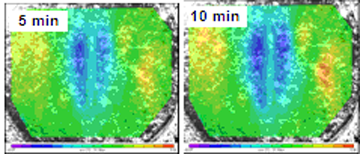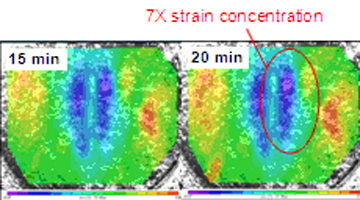![]() Health Monitoring of Energetics
Health Monitoring of Energetics
PI: Dr. Hugh Bruck
Sensing of Strain in Energetics
We have developed a technique for sensing strain in energetics, using Digital Image Correlation (DIC) to track a speckle pattern with a video camera in order to obtain the 2-D deformation fields that characterize strain such as those that develop during curing/aging of a polymer. In the DIC technique, a deformed image is correlated with a reference image to determine the displacement fields associated with the change in position of a subset of the image, typically an area of 100 pixels by 100 pixels. Numerous subsets are correlated over the entire area of interest in the image in order to obtain a displacement field. 2-D splines are then fit to the displacement fields in order to obtain strain fields, typically using an area of 51 data points around each displacement location.
Characterization of Simulants
Sample tested was a highly filled propellant stimulant known as “Polycrete”, which had approximately 88 wt. % solids loading, similar to a propellant. The polymeric binder for Polycrete is a fast-curing, two-part elastomer, similar in mechanical behavior to a propellant binder, and consisted of a mixture of filler sizes ranging uniformly from 50 microns to approximately 2 mm. For the speckling pattern, a combination of white spray paint, solid particles, and aluminum specks were used. From the strain results obtained from DIC over the first hour for this sample, it became apparent that there were trends which were not physically consistent with the curing behavior. For example, the average shear strain was significantly higher than the normal strains. However, almost all of the strains were nearly negligible (less than 100 microstrain) compared to the base polymer. This indicates that there is significant constraint from the filler phase on the polymer curing, and subsequently very high stress development that can lead to faster deterioration and defect development due to aging.
Integrated Sensors
Hard electronic components for sensors have also been integrated into polymers to understand the effect of the sensor on the evolution of strain during curing and during operation of the electronic component. The electronic component was placed in the polymer prior to solidification. The evolution of the strain fields near the electronic component is shown below using DIC contour plots of transverse strain. These results can be used to resolve the strain concentration near the embedded component due to its constraint on the deformation of the polymer, which is about 7X that of the matrix and can lead to premature debonding. Thus, it may be necessary to encapsulate the component in a material, such as a softer polymer, that may reduce the strain concentration due to the constraint of the electronic component. It has also been possible to measure the effects of operating the electronic component and model it with thermomechanical Finite Element Analysis (FEA). Results have indicated that there are very rapid increases in temperature and strain within the polymer adjacent to the electronic component. The axial strains appear to be far less significant than the transverse, which indicates that the component will debond from the polymer and fail to accurately monitor the health of the energetic if the interfacial strength is not adequate. Thus, this technique will serve as a tool for developing appropriate embedded sensor technology.



